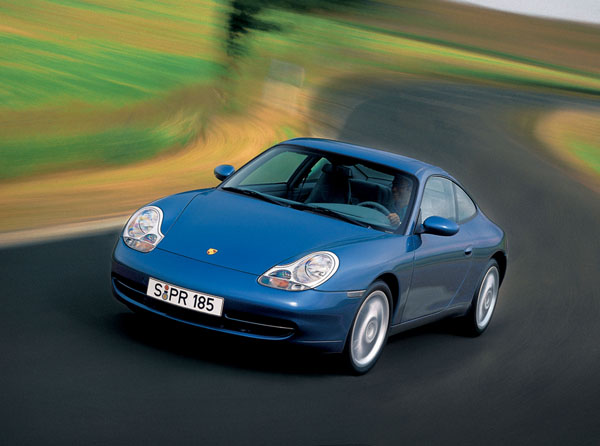
It’s hard to believe that the iconic Porsche 911 is nearing its 60th year. It’s a pure sports machine that once sold new for a reasonable price tag but has become very expensive in recent years. Today’s prices are the result of the German company trying to push itself up into the lower end of the supercar field that’s dominated by the Italians and Brits.
Porsche 911 has its engine behind the back wheels, not in front of them, as in the ideal mid-engined layout. As the engine is way back there there’s room for a sort of back seat. Most Porsche 911s are two-plus-two coupes, there are quite a few Cabriolets and Targas as well.
This engine’s location can make the 911 a handful when cornering hard. Cautious drivers won’t feel comfortable with this. Those who like a bit of excitement and character in their cars love the way the 911 feels – particularly when they push their skills on track days.
The later the Porsche 911 model the easier it is to drive. We begin our used-car review with the 996 Series that was launched in January 1998 because its handling has been significantly tamed. However, we still recommend advanced driving lessons if you’re planning to get serious behind the wheel.
The Porsche 911 997 Series was introduced downunder in October 2004. It saw a return to circular headlight in response to criticisms of the somewhat avantgarde look of the 996’s lights – Porsche enthusiasts have very definite views.
The 997 received a mild facelift in October 2009 to coincide with some major drivetrain changes. A virtually all-new 911, now tagged as the 991 Series (I do wish Porsche would come up with understandable model numbers…) and received major mechanical changes in February 2016, with all-new turbocharged engines.
Porsche 992 Series was introduced in 2018. Visually it has full track width in all models, not only the four-wheel-drive and motorsport variants. The front looks the same, the rear has a full width light bar.
Porsche 911 was famed for having air-cooled engines long after everyone else gave up on them. However, all engines from the 1998 996 Series here have full water-cooling. Clever engineering means the water-cooled engines (almost) sound as though they are air-cooled. We like it like that!
The engines received the efficiency of direct fuel injection with the introduction of the 997 Series II in October 2009 for extra performance. At the same time automatic gearboxes became double-clutch (PDK) seven-speed units. An interesting fact is that Porsche pioneered this type of gearbox for racing cars decades before DCTs were introduced in road cars.
Most Porsches use rear-wheel drive but some have 4WD for additional traction. The latter are heavier because of the additional mechanical components and there are times when they don’t feel quite as handy their dynamics.
Standard Porsches already have stunning acceleration, the Turbo goes even harder The Porsche Turbo is one of the all-time sports car classics and is highly desired by the serious punter.
It’s important a Porsche 911 has been well cared for throughout its life. That doesn’t necessarily mean servicing by an authorised dealer because there are many smaller specialists. These are often people who have spent time in official factory workshops before setting up their own businesses. However, cars with service records by an official dealer are likely to command top dollar.
The Porsche dealer network is well established in Australia and we don’t hear a lot of complaints about parts availability.
Spare parts are expensive, though not outrageously so for a car in this class.
Check with your insurance company before falling in love with a Porsche 911, all the more so if the car has a turbocharged engine. If you have any plans to race, or compete in any format of motorsport, disclose this fact during your application for insurance.
If you can’t afford a late model used Porsche 911 you will find its smaller brothers, the Boxster roadster and Cayman coupe are significantly more affordable.
WHAT TO LOOK FOR
Porsche 911’s body is well engineered and solidly built and ages well, particularly if it’s been owned by someone who has spared no expense to keep it in top form.
If you suspect it has been in a crash have the body and underbody professionally inspected, particularly for correct chassis alignment.
In fact, it’s probably best to have it professionally looked over no matter how good it appears.
Look for oil leaks at the centre of the crankcase where O-rings at the through-bolts may have aged. You may also find oil seepage at the power-steering drive.
Heavy-duty operation of the clutch is likely to mean it’s due for an overhaul. Not a complex job, but there are no cheap repairs on a Porsche.
Look over the condition of the interior for signs of misuse or careless loading of luggage.
Former Porsche 911 racing cars are generally easy to spot and should be avoided unless you want to go racing yourself. In which case check on their track, modification and service history.
HOW MUCH?
Expect to pay from $30,000 to $39,000 for a 2008 Porsche 911 Carrera coupe; $58,000 to $74,000 for a 2009 Targa 4S; $63,000 to $83,000 for a 2011 Carrera S; $72,000 to $95,000 for a 2015 Carrera Coupe; $77,000 to $98,000 for a 2010 Turbo or a 2015 Carrera Cabriolet; $87,000 to $114,000 for a 2013 Turbo Cabriolet; $98,000 to $136,000 for a 2014 Turbo Cabriolet; $132,000 to $174,000 for a 2015 Turbo Cabriolet; $162,000 to $216,000 for a 2017 Twin Turbo Coupe; and $194,000 to $258,000 for a 2019 Carrera 4 GTS Cabriolet.
CAR BUYING TIP
Enthusiasts’ cars either live a pampered life or are fanged here there and everywhere…
RECALLS: To browse recalls on all vehicles go to the ACCC at: www.productsafety.gov.au/products/transport/cars/